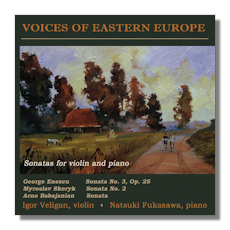
The Internet's Premier Classical Music Source
Related Links
- Enescu Reviews
- Latest Reviews
- More Reviews
-
By Composer
-
Collections
DVD & Blu-ray
Books
Concert Reviews
Articles/Interviews
Software
Audio
Search Amazon
Recommended Links
Site News
 CD Review
CD Review
Voices of Eastern Europe

Sonatas for Violin & Piano
- George Enescu:
- Sonata #3 for Piano & Violin "In the Popular Romanian Character", Op. 25 (1933)
- Myroslav Skoryk:
- Sonata #2 for Violin & Piano (1990)
- Arno Babajanian:
- Sonata for Violin & Piano (1959-1963)
Igor Veligan, violin
Natsuki Fukasawa, piano
North Pacific Music NPMLD037 69:04
Here is tonal and melodic music with wide-ranging sounds, which are often breathtakingly beautiful, sometimes exciting, and invariably pleasurable and satisfying. It is all beautifully played and well recorded. Both soloists have extensive international careers.
Only Enescu (1881-1955), among these composers, is well-known in the west, but the others deserve to be. Skoryk (b. 1938) studied with Kabalevsky, among others, in Russia and Ukraine. He has written concertos for violin, piano and cello, as well as chamber music and film music, some of which reflects a taste for jazz and popular idioms. Babajanian (1921-1983) was Armenian, and was highly honored in the Soviet Union. Richard Cionco, in notes for this release characterizes his music as having "everything from Romanticism to Barbarism and his use of folk material and complex meters and rhythms shows his music to be fresh and progressive. His coloristic sense is extraordinary and his music is, at times, profoundly beautiful."
Enescu's twenty-six and a half minute Sonata is in three movements of roughly equal length, the first of which is called melancholy, the second sustained and mysterious, and the finale, more conventionally Allegro con brio, ma non troppo. The first movement does not strike me as very melancholy; its opening is luscious, with some intensity to follow and a change of pace midway. Harmonies and sonics are interesting, with some very high notes at the end. The second movement also shifts its pace and intensity. The unbuttoned finale, the most folk-like, is something completely different in mood.
Storyk's movements are marked "Word," "Aria" and "Burlesque Vivo." The first opens firmly with a broad theme on the violin; the piano is initially emphatic and is gentle thereafter. The tempo picks up with tapping sounds on the piano and rushing motion from both instruments. The movement ends slowly with staccato playing, gently leading into the beautiful Aria. The tempo taken here is perfectly chosen – satisfyingly unrushed. The violin plays a long melody, with gentle tapping accompaniment, and the sound becomes limpid. The final movement is well named. It is not unrelenting, though, with a welcome pause at one point before its liveliness resumes. The playing is clean and crisp.
The twenty-seven minute Sonata by Babajanian begins with a twelve-minute movement marked Grave; Allegro energico. This designation needs to be understood as including both tempos throughout, not just a slow introduction followed by a fast movement. At first each instrument plays alone – the piano at some length – before they play together. There is a distinct change of pace after a couple of minutes, and a couple of minutes after that. Very vigorous and intense playing with notably full sound yields to relaxed and beautiful quietude. Next is vigorous motion, then slow, soft deliberate solemnity at nine minutes, marked by beats from the piano to the end which can be heard as drum-like or bell-like.
Babajanian's second movement, marked Andante sostenuto, does not really have a sustained tempo throughout either, although it does open with an extended passage with, yes, sustained pizzicato from the violin, and deliberate notes sounded by the piano. Then limpid sounds ensue, and the violin alternates pizzicato and full-toned arco playing, with legato melody in a high register. There is some fast scurrying sound and after a briefly intense moment the movement ends literally on a very high final note.
The Allegro risoluto which follows is indeed resolute, even brashly so, and features varied attacks and dynamics. The violinist leans strongly on the strings and also produces some slashing sounds. Forward motion does not flag until the final minute or so. Meanwhile, very high violin tones are accompanied by very low piano tones. A quiet piano goes from slow to fast. A playful exchange between the instrumentalists is followed by a rather stentorian statement by the violin, vigorously accompanied. After a pause, the movement arrestingly and beautifully comes slowly to a close in an elegiac mood that can even be called sublime, with a very high violin melody and quiet piano tones. In the concluding bars we hear fuller sounds, a piano crescendo and vigorous assertion from the violin.
Highly recommended.
Copyright © 2014, R. James Tobin


















